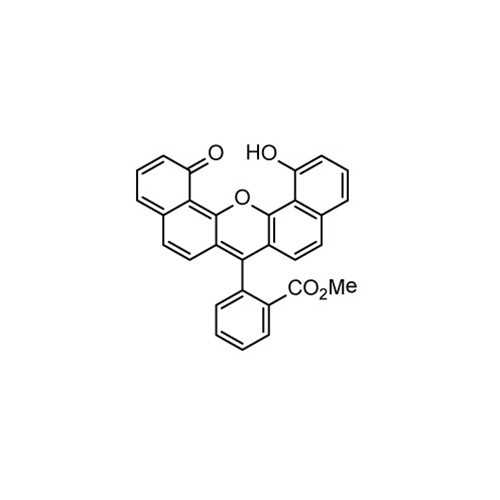RS-11 - Large Stokes-Shift NIR Dye (701 Ex/816 Em)-Acid
RS-11 is a near-infrared fluorescent dye with an excitation of 701nm and emission of 710nm.
The distance between the excitation and emission wavelengths is called the Stokes Shift and is a key aspect in the detection of the emitted fluorescence in biological applications. The detection of emitted fluorescence can be difficult to distinguish from the excitation light when using fluorophores with very small Stokes shifts, because the excitation and emission wavelengths greatly overlap. Conversely, fluorophores with large Stokes shifts are easy to distinguish because of the large separation between the excitation and emission wavelengths. The Stokes shift is especially critical in multiplex fluorescence applications, because the emission wavelength of one fluor may overlap, and therefore excite, another fluor in the same sample.
From the laboratory of Robert M. Strongin, PhD, Portland State University.
RS-11 is a near-infrared fluorescent dye with an excitation of 701nm and emission of 710nm.
The distance between the excitation and emission wavelengths is called the Stokes Shift and is a key aspect in the detection of the emitted fluorescence in biological applications. The detection of emitted fluorescence can be difficult to distinguish from the excitation light when using fluorophores with very small Stokes shifts, because the excitation and emission wavelengths greatly overlap. Conversely, fluorophores with large Stokes shifts are easy to distinguish because of the large separation between the excitation and emission wavelengths. The Stokes shift is especially critical in multiplex fluorescence applications, because the emission wavelength of one fluor may overlap, and therefore excite, another fluor in the same sample.
From the laboratory of Robert M. Strongin, PhD, Portland State University.
| Product Type: | Small Molecule |
| Name: | (methyl 2-(13-hydroxy-1-oxo-1H-dibenzo[c,h]xanthen-7-yl)benzoate or 2-(13-hydroxy- 1-oxo-1H-dibenzo[c,h] xanthen-7-yl)-benzoic acid, methyl ester |
| Chemical Formula: | C29H18O5 |
| CAS number: | 1380077-17-7 |
| Molecular Weight: | 446.45 |
| Extinction Coefficient: | 12,633 in MeOH |
| Tested Applications: | NIR chromophore, potential solar cell application, model compound exhibiting low barrier hydrogen bond |
| Ex/Em Maxima: | Emission at 816 in MeOH |
| Abs Max (nm): | 701 in MeOH |
| Detection Method: | Fluorescence |
| Storage: | -20C; protect from light |
| Shipped: | Cold packs |
- Sibrian-Vazquez M, Escobedo JO, Lowry M, Strongin RM. Progress toward red and near-infrared (NIR) emitting saccharide sensors. Pure Appl Chem. 2012 Nov 1;84(11):2443-2456.
- J. Am. Chem. Soc. 2012, 134, 10502-10508.
If you publish research with this product, please let us know so we can cite your paper.


